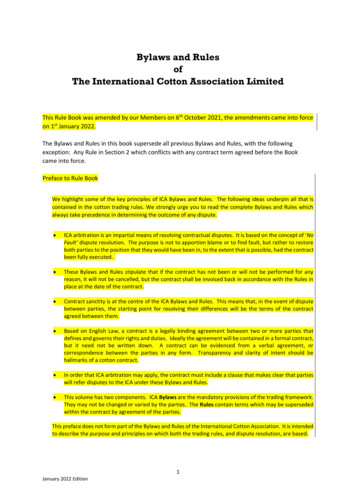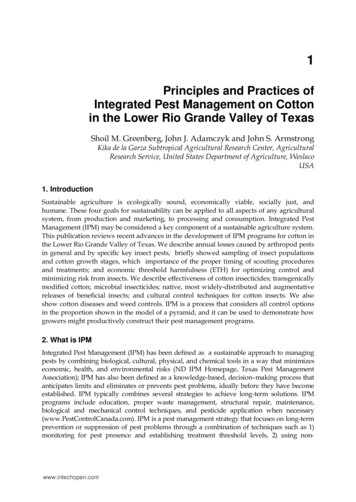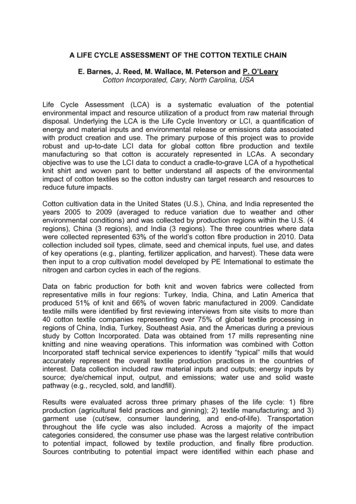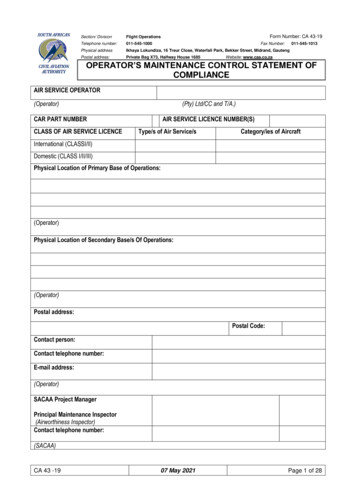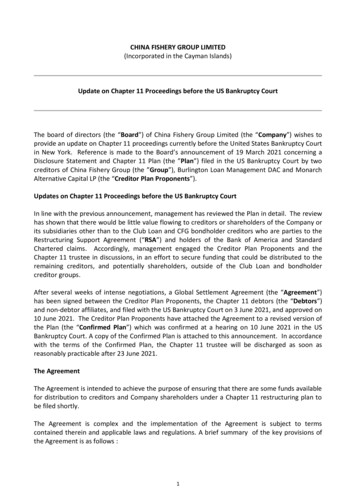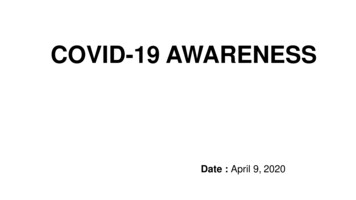
Transcription
NAMOI COTTON LIMITEDCORPORATEGOVERNANCESTATEMENT2022NAMOI COTTON LIMITEDABN 76 010 485 588
2022 Namoi Cotton Limited Corporate Governance StatementNamoi Cotton Limited (‘Namoi Cotton’ or the ‘Company’) has adopted a program to review andimprove its charters, policies and procedures periodically as required to ensure its corporategovernance framework remains current and compliant with best corporate practice.Namoi Cotton’s corporate governance practices are outlined in this Corporate Governance Statementand addresses the ASX Corporate Governance Council’s ‘Corporate Governance Principles andRecommendations’ – 4th Edition released in 2019 (referred to as ‘ASX Principles orRecommendations’). Namoi Cotton has lodged with ASX the Appendix 4G (Key to Disclosures –Corporate Governance Council Principles and Recommendations) together with this CorporateGovernance Statement and the Company’s 2022 Annual Report.The Namoi Cotton Charters and Policies for the Board and its current Board sub-committees referredto in this Corporate Governance Statement are available in the Corporate Governance section ofNamoi Cotton’s website at e/ (collectivelysuch policies are known as the “Corporate Governance Documents”). A copy of the 2022 AnnualReport is also available on the Namoi Cotton website at Investors Namoi Cotton.The 2022 Corporate Governance Statement is dated 8 July 2022 and covers the corporate governancepractices and policies in place during the financial year ending 28 February 2022 and up to the date ofthis report. The 2022 Corporate Governance Statement was approved by the Board on 11 July 2022.During the financial year ended 28 February 2022 and to the date of this report, the Board hasundertaken a thorough review of its governance charters and policies to strengthen and enhance thecompany's governance platform. Namoi Cotton has monitored and updated the Company’s riskmanagement framework, including a review and identification of requisite Board skills, to ensure thatthe Company is in a strong and sustainable financial and operating position to achieve its strategicgoals.The Board Charter, Audit, Risk and Compliance Committee Charter, People Culture and NominationCommittee Charter, and Safety Committee Charter were all reviewed during calendar year 2022 toimprove Board and committee governance standards to achieve a higher standard of accountability,transparency and reporting in the company, and also to address the 4th edition ASX CorporateGovernance Principles and Recommendations. The various Board sub-committees are governed bytheir respective Charters which sets out the Committee’s purpose, responsibilities, role, membership,meeting process, Board reporting obligations and assessment of performance.The Board has taken a proactive approach to revising its governance policies and procedures toaddress the 4th edition ASX Corporate Governance Principles by initiating a review of its Code ofConduct, Risk Management Policy, Anti-bribery and Corruption Policy, Disclosure and CommunicationPolicy, Diversity Policy, and a company-wide review of internal policies and procedures. TheCompany’s Whistleblower Policy addresses and complies with the amendments to the CorporationsAct 2001 (Cth) and the Taxation Administration Act 1953 (Cth) that are effective from 1 July 2019.The Board sub-committees review matters designated within their respective Charters and makerecommendations to the Board. The Board and sub-committee composition and attendance are setout in the Directors’ Report within the 2022 Annual Report. The qualifications of Board and committeemembers and attendance at meetings is included in the Directors Report of the 2022 Annual Report.Structure and Composition of the BoardThe Namoi Cotton Constitution (“Constitution”) provides that the Board must comprise an evennumber of Directors that is not more than a maximum of 8. Article 11.3 of the Constitution requires2
that at all times one-half of the total number of Directors must be Grower Directors (the “GrowerDirector Representation Rule” or “Rule”) for so long as the Grower Directors Representation applies.In accordance with the Constitution, the continuation of this Rule will be considered by shareholdersat the 2022 Annual General Meeting (“AGM”). If shareholders approve the continuation of this Ruleat the 2022 AGM, the Constitution requires shareholders to consider the Rule again at the 2027 AGM.If shareholders do not approve the continuation of this Rule at the 2022 AGM, the provisions of theConstitution relating to the Rule and any requirements imposed on Grower Directors will cease toapply at the conclusion of the 2022 AGM.The Company has vacant Grower Director positions since the retirement of Glen Price in July 2021 andthe recent change in classification of Tim Watson from Non-Executive Grower Director to NonExecutive Director.If shareholders do not approve the continuation of this Rule at the 2022 AGM, shareholders willconsider removing the requirement to have an even number of directors at the 2022 AGM.Article 12 of the Constitution sets out the requirements to be eligible for a Grower Director.A copy of the Constitution is available nce/.theNamoiCottonwebsiteatAs at the publication of this governance statement the Non-Executive Director on the Board who isclassified as being a Grower Director is Mrs Juanita Hamparsum. Tim Watson who is a Non-ExecutiveDirector, ceased to be classified as a Grower Director in 2022.PRINCIPLE 1: LAY SOLID FOUNDATIONS FOR MANAGEMENT AND OVERSIGHTRecommendation 1.1 – Roles and ResponsibilitiesThe Board’s responsibilities and reserved decision-making parameters are set out in the BoardCharter. The roles and responsibilities of the Board are defined in the Board Charter, and therespective Board sub-committee Charters (all of which are available on the Namoi Cotton website).During the 2022 financial year the Board delegated day to day management, operation andadministration of Namoi Cotton to the Chief Executive Officer (“CEO”), who has the authority to subdelegate his duties to various members of the executive management team. The Board is responsiblefor reviewing the performance of the CEO.Mr John Stevenson was appointed to the position of CEO of Namoi Cotton on 7 June 2021 and remainsin that role as at the date of this Corporate Governance Statement. Mr Stevenson was appointed ChiefFinancial Officer (“CFO”) on 30 March 2020 and was replaced by Ms Sonya Ryan who commenced inthe CFO position on 10th January 2022.Recommendation 1.2 – Director selectionThe process of the appointment and removal of Directors is governed by the Constitution.The Board has a People, Culture, and Nomination Committee (“PCNC”) which has the responsibilityfor recommending to the Board candidates to be considered or nominated to act as a Director for theBoard.If a new Director is appointed by the Board as a casual vacancy or as an addition to the existingDirectors during the year, then such appointee holds office until the conclusion of the next AGM ofthe Company and is eligible for election at that meeting.In considering candidates for the selection, election and appointment to the Board, the PCNC and theBoard assess a candidate’s background, qualifications, industry experience and personal attributes. As3
part of this process and at regular intervals, the Board will conduct a skills assessment to ensure thatDirectors possess the appropriate skills, experience, and attributes to govern the Company.The Board undertakes appropriate checks before appointing a new Director including referencechecks, criminal and bankruptcy checks, academic qualifications checks and where applicable, GrowerDirector checks to ensure they meet the Grower Directors qualifications under the Constitution.Recommendation 1.3 – Terms of AppointmentNamoi Cotton has written agreements with all Directors setting out the key terms and responsibilitiesof their appointment. Senior Executive employment contracts clearly state the terms of appointmentand the expectations of the Company regarding performance including any performance-basedincentives.Recommendation 1.4 – Company SecretaryThe Company Secretary has access to all Board members. The role of the Company Secretary is outlinedin the Board Charter. The Company Secretary assists and advises the Board on governance andcompliance matters.Company Secretarial services are managed jointly by Ms Sonya Ryan and Mr John Stevenson, with MrAndrew Metcalfe acting in an advisory capacity. Mr Metcalfe is an experienced independent Companysecretary and governance consultant, having been a Company secretary and governance advisor toASX listed companies for over 20 years.Recommendation 1.5 – Diversity PolicyDiversity within Namoi Cotton is created by an inclusive working environment. Namoi Cotton haspublished its Diversity Policy on its website nce/, which promotes diversity of religion,race, ethnicity, gender, disabilities, age, cultural background, socio-economic background, sexualorientation, perspective, experience and other areas of difference.In respect of the diversity strategy, the Board and Management: promote diversity in the Namoi Cotton workplace. support equal opportunity in the recruitment, selection and promotion of employees fromdifferent backgrounds, knowledge, gender and experience. The Namoi Cotton recruitmentprocess is structured to provide equality in recruitment and unbiased selection and promotiondecisions.The Diversity Policy includes measurable diversity objectives that are reflected in the recruitmentpolicy. The Board, in consultation with the PCNC, set measurable objectives for achieving diversity, inparticular gender diversity. The intention is to achieve the objectives over time.Measurable diversity metrics include: representation of roles by age and gender for Management, Team Leaders and Board levels. gender salary comparison in same role and same level positions. gender representation in talent and succession planning; and setting diversity targets.As at the date of this Corporate Governance Statement, 20% of Namoi Cotton’s employees (prior year17.9%) is made up of women employed across all sites and locations. Namoi Cotton is committed to adiversity strategy aimed to promote the appointment of qualified, experienced, and diverse Directors,4
Management and Employees to achieve Namoi Cotton’s objectives on diversity.Namoi Cotton’s Workplace Gender Equality Act public report for 2021 is available on its website nce/.Recommendation 1.6 – Board and Committee Performance and EvaluationThe Board conducts annual evaluations of its performance and the performance of its Board subcommittees. The process of performance review enables the Board to identify areas for improvement.The Board performance evaluation, amongst other things, is based on Namoi Cotton’s performanceagainst long term objectives, the business plan and budgeted performance.An external performance and evaluation of the Board and its Board sub-committees was undertakenin the reporting period. The report confirmed that the current Board have the appropriate mix of skill,experience and expertise to execute the Company’s objectives and strategies.Recommendation 1.7 – Senior Management Performance and EvaluationNamoi Cotton’s Corporate Governance Documents detail the procedures for performance review andevaluation. Senior Management are evaluated against individual performance and business measureson an ongoing basis. Namoi Cotton sets key performance indicators for its senior executives andperformance is evaluated against these targets annually.PRINCIPLE 2: STRUCTURE THE BOARD TO ADD VALUERecommendation 2.1 – People, Culture and Nomination CommitteeNamoi Cotton has established a People, Culture and Nomination (‘PCNC’) Committee to assist theBoard in reviewing succession planning, remuneration policies and practices. The PCNC Charter setsout the Committee’s responsibilities, structure, access to resources and information, meetingprocesses and performance evaluation. In addition, the Board has adopted a Remuneration Policywhich is available on the Namoi Cotton website.The primary function of the PCNC is to assist the Board in fulfilling its corporate governanceresponsibilities to: ensure the Company has the appropriate ethical standards and corporate governance policiesand practices in place in order to protect and enhance shareholder returns. ensure, so far as possible, that policies are properly embedded within the Company’soperations and that all who work for and with the Company embrace these polices andstandards as a normal and necessary element of managing the Company to maximise value forshareholders. establish appropriate remuneration levels and policies including incentive policies for seniorexecutives; and identify and select appropriate individuals for nomination as members of the Board.The Committee’s Charter provides that the Committee meets at least twice per annum and itsmembers comprise of at least three (3) non-executive directors including an independent chairperson.5
Recommendation 2.2 – Skills of DirectorsThe Board composition requirements under the Constitution aims to achieve a mix of industry,finance, governance, trading, risk management, compliance, people, culture, digital and strategyexperience. The composition is reviewed annually by the Board with the qualifications and experienceof each Director set out in the Directors Report of the 2022 Annual Report.A Board Skills Analysis was undertaken during the 2022 reporting period and the following chartdepicts the mix of skills the Board currently has while providing guidance for expanding the skills baseof Directors for the future needs of the Company.Eligibility criteriaAs laid out in Article 12.2 of the Constitution, to be eligible as a Grower Director a person must (insummary): have ginned at least 1,500 cotton bales in aggregate per cotton season at a Namoi Cotton ginin at least three out of the last five cotton seasons; and have ginned: (i)at least 50% of their seed cotton production at any Namoi Cotton gin in at leastthree out of the last five cotton seasons; or(ii)at least 50% of their seed cotton production which is grown within 100 kilometresof any Namoi Cotton gin at a Namoi Cotton gin in at least three out of the last fivecotton seasons; andis the registered owner or lessee (of a long-term lease) of cotton farming property which canplant a minimum of 150 hectares of seed cotton annually and is capable of producing 1,500cotton bales in aggregate per cotton season to be ginned at a Namoi Cotton gin,Or:6
be employed in a senior executive or senior managerial role by a client of Namoi Cotton whohas, or which has a significant involvement in the Australian cotton industry (and have heldthat position for at least 5 years); and have had their nomination as a Grower Director unanimously approved by the Directors.Exemptions and annual reviews of eligibility criteriaIf a Grower Director ceases to satisfy any of the eligibility requirements set out above due to drought,flood or loss of crop due to hail or spray drift, then the Directors may, in their absolute discretion,provide an exemption for one cotton season for that Grower Director when applying the eligibilityrequirements. The Directors must also review the eligibility of each Grower Director by assessing anddetermining whether they continue to satisfy the eligibility requirements on an annual basis at least 3months prior to each AGM.As at the publication of this governance statement the Non-Executive Director on the Board who isclassified as being a Grower Director is Mrs Juanita Hamparsum. Tim Watson who is a Non-ExecutiveDirector on the Board, ceased to be classified as a Grower Director in 2022.Board composition and length of serviceThe Board Charter states that directors have a maximum term of 12 years of continuous service andare subject to the retirement provisions contained in the Constitution and the ASX Listing Rules.The Board composition, experience and skills is reviewed annually and as at the date of this CorporateGovernance Statement the Board comprises (5) Non-Executive Directors.NamePositionAppointment DateLast Re-ElectionTim WatsonChairman & Non-ExecutiveDirector17 December 20142020 AGMRobert GreenNon-Executive Director27 May 20132019 AGMJuanita HamparsumNon-Executive Grower Director7 June 20182021 AGMJoseph Di LeoNon-Executive Director7 June 20182021 AGMIan WiltonNon-Executive Director17 June 20202020 AGMDetails of each Director including skills, experience and expertise are included in the 2022 AnnualReport which is available on the Namoi Cotton website at Investors Namoi CottonRecommendation 2.4 - Majority should be Independent DirectorsThe Board supports the principle that a majority of the Board should be independent. Whendetermining the independent status of a Director, the Board considers whether the Director: is a substantial shareholder of Namoi Cotton or an officer of, or otherwise associated directlywith, a substantial shareholder of Namoi Cotton, is employed, or has previously been employed in an executive capacity by Namoi Cotton oranother member of the Namoi Cotton group, and there has not been a period of at least threeyears between ceasing such employment and serving on the Board, has within the last three years been a principal of a material professional adviser or a materialconsultant to Namoi Cotton or another member of the Namoi Cotton group, or an employeematerially associated with the service provided, is a material supplier or customer of Namoi Cotton or another member of the Namoi Cotton7
group, or an officer of or otherwise associated directly or indirectly with a material supplieror customer; and has a material contractual relationship with Namoi Cotton or another member of the NamoiCotton group other than as a director.The Board, when assessing materiality, considers a qualitative approach rather than settingquantitative thresholds. In accordance with the Namoi Cotton governance policies, a relationship willbe assessed as “material” in context of the nature, circumstance and activities of Namoi Cotton andthe Director’s activities or its affiliates’ activities.The Constitution of the Company requires the Board to comprise an even number of Grower Directorsand Non-Grower Directors. Board recognises the need to have a majority of independent Directorsbut additionally that Board members must add value to the Company. The Board further recognisesthe need for the Board to comprise Directors who have a strong understanding of the Namoi Cottonbusiness and the cotton industry, however with the ability to bring independent views and judgementto Board decision making and deliberations.The Board must have Grower Directors who are required to have business relationships with NamoiCotton for the ginning of cotton. Additionally, the Grower Directors must have the skills, knowledge,qualifications, and experience necessary to facilitate the proper functioning of the Board.Mrs Hamparsum, as a Grower Director, is a cotton producer and sells cotton to Namoi Cotton and usesthe Company’s ginning services. The Board regularly assesses whether or not the nature and extent ofthose transactions would cause the Grower Director not to be considered independent. The Board issatisfied that a Director is independent as to the nature and magnitude of their dealings with NamoiCotton when they do not cause the Board to consider that the relationship would materially interferewith their independence when exercising their judgment. Mrs Hamparsum is capable of exercisingindependent judgement on all Board decisions.Conflicts of InterestImportantly, the Board has in place a process to ensure that conflicts of interest are managed.The Code of Conduct provides that Directors must act in the best interests of the Company and mustavoid participating in decisions and activities which may conflict, or be perceived to conflict, with theirduties and responsibilities to Namoi Cotton.The Directors must not enter into any arrangement or participate in any activity that would conflictwith Namoi Cotton’s best interests or would be likely to negatively affect Namoi Cotton’s reputation.If a potential conflict arises the Director must immediately advise the Board of the conflict of interest.If a potential conflict arises or is notified by the Director to the Board then the relevant Director withthe conflict-of-interest issue must not participate in the discussion on the matter, receive Boardpapers on the matter and must leave the Board meeting whilst the matter is being considered. Areview of Directors’ interests is made at every Board and sub-committee Meeting.Recommendation 2.5 - Chairperson should be Independent and not CEOThe Board Charter provides that the Chairperson is an independent director and not the CEO. Mr TimWatson is the Chairman and a Non-Executive Director.Namoi Cotton acknowledges that a separation of roles between the chairperson and CEO is bestpractice corporate governance, to minimise the possibility of a lack of transparency and promoteconstructive debate at Board level.Recommendation 2.6 - Induction program for New Directors8
Namoi Cotton has a program of induction for new Directors. New and existing Directors are offeredprofessional development opportunities and training internally and externally. Each Director may takeindependent legal advice at the expense of Namoi Cotton.PRINCIPLE 3: INSTILL A CULTURE OF ACTING LAWFULLY, ETHICALLY AND RESPONSIBLYRecommendation 3.1 – Company ValuesNamoi Cotton’s purpose is to provide cotton growers an independent pathway to market whilst addingvalue along the supply chain. The Company’s core values are:a) Integrity – We keep our promises. We hold ourselves accountable to our commitments.We encourage everyone to have a voice to bring together many minds. We embracediversity and differences in others. We speak out on bullying and harassment.b) Teamwork – We build strong partnerships with our customers and each other. We elevateothers and celebrate collaboration. We promote a workplace that fosters friendship andloyalty. We support our local communities and environment.c) Safety – We place safety and health first. We take responsibility for the safety and health ofourselves and others. We promote a safe workplace and never walk past unsafe practices.We report, learn and improve from our safety incidents.d) Excellence –We are efficient and effective and get the job done. We put ourcustomers at the forefront in our pursuit for high quality outcomes. We operate withoptimism and resilience. We are a market leader driven by innovation and taking boldsteps.Recommendation 3.2 – Code of ConductThe Code of Conduct guides and applies to the Directors, the CEO, management, employees and thirdparties dealing with Namoi Cotton. The purpose of the Code of Conduct is to provide a frameworkfor decisions and actions in relation to ethical and responsible conduct in employment. Itunderpins the Company's commitment to integrity and fair dealing, to act ethically, sustainably,and responsibly in its business affairs, and to display and exercise a duty of care to all employees,clients and stakeholders. The Board has adopted the Code of Conduct and is committed to upholdingthe Company’s core values and ensuring that all business affairs of Namoi Cotton must be conductedlegally, ethically, honestly and with integrity, and which also sets out the conduct and behaviourexpected for employees, consultants, contractors, and business partners of Namoi Cotton. The Codeof Conduct addresses Namoi Cotton’s position on personal and professional behaviour, ethicalstandards and policies, conflicts of interest, anti-bribery and corruption, dealings with external parties,confidentiality, privacy, fair dealing, discrimination, bullying, harassment, vilification, health andsafety, compliance with laws and regulations, responsibility to shareholders and the financialcommunity. A copy of the Namoi Cotton Code of Conduct is available on the Namoi Cotton website nce/.Recommendation 3.3 - Whistleblower PolicyNamoi Cotton has adopted a Whistleblower Protection Policy (“WPP”) that complies with theamendments to the Corporations Act 2001 (Cth) and the Taxation Administration Act 1953 (Cth) thatare effective from 1 July 2019.The WPP is underpinned by a strong commitment to building a culture in Namoi Cotton that reflectssound governance and promotes ethical behaviour in the detection and management of fraudulent,corrupt, or improper conduct. The WPP provides protection to whistleblowers by establishing amechanism for concerns to be raised on a confidential basis without fear of intimidation or reprisal.9
The WPP applies to any individual who is either a current or former officer and director, employee,contractor, supplier, unpaid worker, or relative, dependent or spouse of any officer, employee,contractor and supplier, and collectively, to Employees and Stakeholders.Whistleblowers perform a vital role in the community in exposing fraud, corruption and othermisconduct, and whistleblowing ensures that corporate entities and organisations are held to accountand operate within the confines of the law.Employees and Stakeholders can raise any misconduct and unethical behaviour in relation to NamoiCotton to the Chair of the Audit, Risk and Compliance Committee, or a person authorised by NamoiCotton to receive disclosures that may qualify for protection (Whistleblower Protection Officer).Employees and Stakeholders can also raise misconduct and unethical behaviour in relation to NamoiCotton via a dedicated phone number and email address available to Employees and Stakeholders andcan choose to remain anonymous to ally fear of retribution. A whistleblower cannot be subject to anycivil, criminal, or administrative liability (including disciplinary action) for making a protecteddisclosure. A whistleblower cannot be subjected to any detriment or a threat of detriment becausethey made, or are believed to have made, a protected disclosure.A copy of the Whistleblower Protection Policy is available on the Namoi Cotton website nce/.Recommendation 3.4 - Anti-bribery and Corruption PolicyAustralia has strict laws against bribery and corruption. The anti-bribery laws of some countriesincluding Australia, the United States and United Kingdom can apply to actions carried out in othercountries (i.e. wide-reaching extra-territorial effect). Responsible persons must comply with anduphold all laws against bribery, corruption and related conduct applying to the Company in all thejurisdictions where the Company operates.Corrupt conduct involves the dishonest or partial use of power or position which results in oneperson/group being advantaged over another. Corruption can take many forms including, but notlimited to:(a) official misconduct;(b) bribery and blackmail;(c) unauthorised use of confidential information;(d) fraud; and(e) theft.Accordingly, Namoi Cotton has a strict policy not to offer or receive secret commissions or bribes tofurther its business interests.Namoi Cotton is committed to adopting effective systems to counter bribery and related improperconduct and to monitor and enforce these systems.Share Trading PolicyThe Board has adopted a Share Trading Policy which regulates dealing in Namoi Cotton securities byDesignated Persons including Directors, Key Management Personnel, employees, contractors andconsultants of Namoi Cotton and their related parties. Designated Persons must not deal in NamoiCotton securities if they are in possession of price sensitive information which would, if theinformation were publicly known, be likely to have a material effect on the price or value of NamoiCotton Securities; or influence persons who commonly invest in securities in deciding whether or notto deal in Namoi Cotton Securities. Under the Share Trading Policy, Designated Persons must not buy,10
sell or subscribe for Namoi Cotton securities except during permitted periods.The Share Trading Policy provides that Designated Persons may not deal in Namoi Cotton securitiesduring the following periods:a) the period from the end of the Company’s financial year (28 February, or 29 February in a leapyear) until 48 hours after the announcement of the full year financial results for Namoi Cotton arereceived and announced to the general market by the ASX;b) the period from the end of the Company’s half year (31 August) until 48 hours after theannouncement of the half year financial results are received and announced to the general marketby the ASX; andc) the period of 48 hours after the issue of any release to the general market by the ASX; andd) at any other time for a specified period as determined by the Board of Namoi Cotton.A breach of the Share Trading Policy will be regarded by Namoi Cotton as serious misconduct whichmay lead to disciplinary action and/or dismissal.A copy of the Share Trading Policy is available on the Namoi Cotton website nce/.PRINCIPLE 4: SAFEGUARD INTEGRITY OF CORPORATE REPORTSRecommendation 4.1 – Audit, Risk and Compliance CommitteeThe Board has established an Audit, Risk and Compliance Committee (“ARCC”) which is governed bythe Audit, Risk and Compliance Committee Charter and whose primary responsibility is to oversee theaudit functions of the Company and ensures risks are identified and managed.The Charter sets out its authority, objectives, structure, responsibilities, membership, meetingprotocols, access to company personnel and information, reporting requirements and p
particular gender diversity. The intention is to achieve the objectives over time. Measurable diversity metrics include: representation of roles by age and gender for Management, Team Leaders and Board levels. gender salary comparison in same role and same level positions. gender representation in talent and succession planning; and
